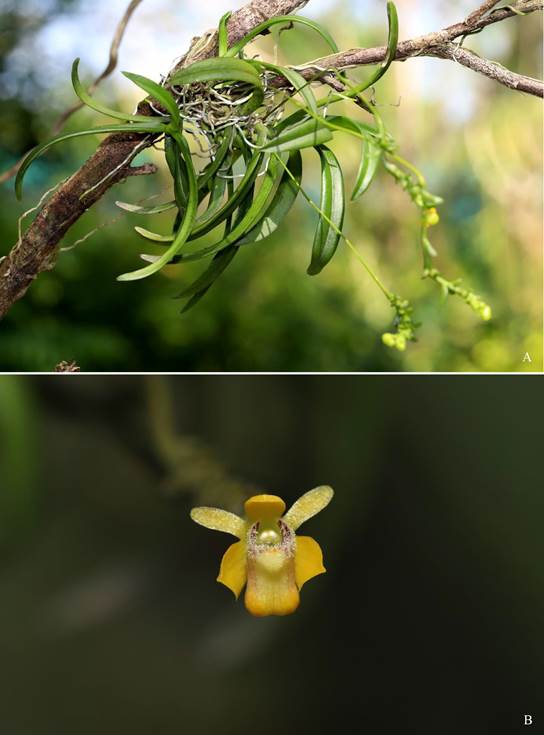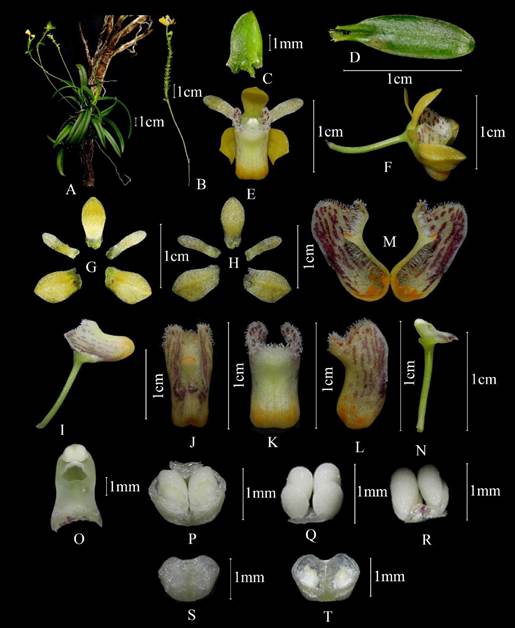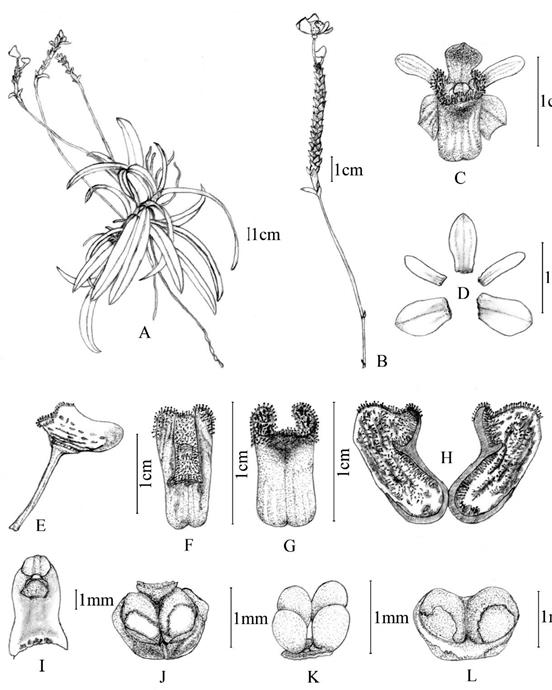Introduction
Thrixspermum Lour. comprises epiphytic, or rarely terrestrial plants characterized by a callus in front of the sac of the lip, the short column with a broad foot, and the four pollinia united in unequal pairs on a short broad stipe (Seidenfaden 1988). The genus includes around 160 species (Chase et al. 2015) distributed widely from the Himalayas to the Philippines, Malesia, Northern Australia, and the Pacific islands (Govaerts et al. 2016). It is represented by 16 species in India of which nine species are recorded from Northeast India (Misra 2019). Seven species have been recorded from Assam: Thrixspermum acuminatissimum (Blume) Rchb.f., T. centipeda Lour., T. formosanum (Hayata) Schltr., T. merguense (Hook.f.) Kuntze, T. musciflorum A.S.Rao & Joseph, T. pygmaeum (King & Pantl.) Holttum, and T. trichoglottis (Hook.f.) Kuntze (Gogoi 2018a). Thrixspermum has been little studied by botanists (O'Byrne & Vermeulen 2008). During a field trip under the “Biodiversity Documentation Programme, Jeypore Reserve Forest''to Dehing Patkai National Park, Dibrugarh district of Assam on 5 December 2010, the author collected an unidentified epiphytic orchid with an immature inflorescence. The orchid was brought under cultivation at the Regional Orchids Germplasm Conservation and Propagation Centre (Assam Circle), where it has flowered every year since. However, this species was erroneously recorded by ( Gogoi 2012a, 2012b, 2018a, 2018b, 2019a, 2019b), Gogoi & Yonzone (2015), and ( Gogoi et al. 2012a, 2012b, 2012c, 2015) as T. pygmaeum without studying the type specimen and protologue (King & Pantling 1898). A critical study based on the available literature (Chen et al. 2009, Chowdhery 1998, Gogoi 2018a, 2019a, 2019b, Gogoi et al. 2015, Hegde 2017, King & Pantling 1898, Kumar et al. 2017, Lucksom 2007, Maina et al. 1998, Mao et al. 2011, Pearce & Cribb 2002, Pradhan 1979, Rao 2010, Seidenfaden 1975, Singh et al. 2019) and the comparison with the herbarium specimens of Thrixspermum collections deposited in the local herbaria proved that the present specimen is an undescribed species. Hence, it is here described and illustrated as a new species.
Materials and methods
All the photos were taken with a Canon 6D Mark-II fitted with an EF 100 mm f/2.8L Macro USM lens. The measurements and species description were made from living plants following the terminology for morphological descriptions by Beentje (2012). Specimens were deposited at the Herbarium of the TOSEHIM, the Orchid Society of Eastern Himalaya, Assam and OHT, Orchid Herbarium Tipi, Arunachal Pradesh.
Taxonomic treatment
Thrixspermum patkaiensis K.Gogoi, sp. nov. (Fig. 1-3).
TYPE: India. Assam: Tinsukia district, Dehing Patkai National Park, 200 m, 5 December 2010, K. Gogoi 00956 (holotype: TOSEHIM, Herbarium of the Orchid Society of Eastern Himalaya; isotype: OHT, Orchid Herbarium Tipi).
Diagnosis: The present new species is morphologically similar to Thrixspermum musciflorum A.S.Rao & Joseph, T. formosanum (Hayata) Schltr., and T. pygmaeum (King & Pantl.) Holttum, but differs from these species by the 12-18 cm long inflorescence with 2.5-5.0 cm long rachis; yellow or pale-yellow flowers; lip yellow with white or pale yellow in-front, streaked with purplish stripes and glandular-hairy on both sides of the lateral lobes; epichile forming a glandular hairy rim and the disk with long hairs.

A. Natural habit.
B. Close-up of the flower.
Photos by Khyanjeet Gogoi.
Figure 1 Thrixspermum patkaiensis.

A. Habit.
B. Inflorescence.
C-D. Floral bracts.
E. Flower, ventral view.
F. Flower, lateral view.
G. Dissection of the perianth, ventral view.
H. Dissection of the perianth, dorsal view.
I. Lip, column, and ovary, lateral view.
J. Lip, ventral view.
K. Lip, dorsal view.
L. Lip, lateral view.
M. Lip, longitudinal section.
N. Ovary with pedicel and column.
O. Column, ventral view.
P. Anther cap with pollinia, ventral view.
Q. Pollinarium, ventral view.
R. Pollinarium, dorsal view.
S. Anther cap, dorsal view.
T. Anther cap, ventral view.
Photos by Khyanjeet Gogoi.
Figure 2 Thrixspermum patkaiensis.

A. Habit.
B. Inflorescence.
C. Flower, ventral view.
D. Perianth, ventral view.
E. Lip with ovary and column, lateral view.
F. Lip, ventral view.
G. Lip, dorsal view.
H. Lip, Longitudinal section.
I. Column, ventral view.
J. Anther cap with pollinia, ventral view.
K. Pollinarium, ventral view.
L. Anther cap, ventral view.
Drawing by Khyanjeet Gogoi.
Figure 3 Thrixspermum patkaiensis.
Plant epiphyte, erect, 5-10 cm tall, monopodial; roots slender, extra-axillary. Stems 2-6 cm long, with 4-12 leaves, branched towards the base, lower portion enclosed with remnant of scarious sheaths. Leaf 5-7 × 0.8-1.0 cm, linear or linear-lanceolate or narrowly oblong, acute, green, glabrous, channeled, fleshy, weakly bilobed at apex, curved downward, distichous. Inflorescence 1-4, terete, glabrous, suberect, stout, arising from the axils of lower stems, 12-18 cm long, ca. 1 mm diam., peduncle 9-12 cm long, terete, glabrous with 2-3, 0.1-0.2 cm long sterile bracts; rachis 2.5-5.0 cm long, glabrous, with 1-2 pedicellate flowers; floral bracts triangular or leaflike, 0.3-1.0 × 0.12-0.40 cm, ovate, acute, glabrous. Flowers 1.3-1.5 cm across, fragrant, yellow, spreading. Sepals sub-equal, spreading, yellow or pale yellow. Dorsal sepal 0.6-0.8 × 0.3-0.4 cm, oblong or elliptic, acute or sub-acute, concave, glabrous. Lateral sepals 0.6-0.7 × 0.4-0.5 cm, obliquely obovate or ovate-elliptic, acute or obtuse, glabrous. Petals 0.6-0.7 × 0.10-0.15 cm, obovate-oblong, obtuse, spreading, curved backward, glabrous. Lip 0.7-0.8 cm long, adnate to the base of column foot, 3-lobed, yellow with white or pale yellow in-front, streaked with purplish stripes both side; hypochile projected into a scrotiform spur, spur shallowly bilobed, lobules of spur obtuse; lateral lobes 0.2-0.3 cm, erect, subovate, obtuse, with glandular hairs both sides; epichile reduced, emarginate in front, narrow, inflexed, with glandular hairs on the rim; yellow with white or pale yellow in the middle; disk pale yellow, orange yellow at base, with a median longitudinal lamella covered with dense glandular hairs, starting from the base up to apical lobe, disc with long hairs and with a fleshy scale like appendage. Column 0.25 × 0.20 cm, white. Anther 0.15 cm long ovate, glabrous. Pollinia 4, 0.6 mm long, white, unequal. Capsule 5-8 × 0.3-0.4 cm, linear-cylindric, ribbed, glabrous.
Flowering: from May to October.
Habitat: Epiphytic on tree trunks in tropical mixed evergreen forest at 200 m in Dehing Patkai National Park of Tinsukia district, Assam.
Distribution: Only known from India (Dehing Patkai National Park, Tinsukia District of Assam) (Fig. 1A)
Etymology: The specific epithet refers to the Dehing Patkai National Park, Assam in Northeast India where from the plant was collected.
Table 1 Differences between Thrixspermum formosanum, T. musciflorum, T. patkaiensis, and T. pygmaeum.
| T. formosanum | T. musciflorum | T. patkaiensis | T. pygmaeum | |
| Stem | 1-2 cm long, with 4-5 leaves. | up to 1.5-2.0 cm long, with 4-6 leaves. | 2-6 cm long, with 4-12 leaves. | 0.8-1.0 cm long, with 2-5 leaves. |
| Leaves | 4-6 × 0.4-0.9 cm, linear-lanceolate or narrowly oblong, abaxially often spotted with purple. | 2-6 × 0.3-0.5 cm, narrowly oblong, Vshaped in section, trigonal, acute, keeled at apex. | 5-7 × 0.8-1.0 cm, linear or linearlanceolate or narrowly oblong, curved downward, distichous, weakly bilobed at apex. | 2-7 × 0.5-1.0 cm, linear oblong, acuminate. |
| Inflorescence | 4-6 cm long; rachis short, slender; peduncle 3-5 cm long, suberect, slender, straight, with 2 sterile bracts; rachis short, 0.3-0.5 cm long, green, thickened, with 1-2 pedicellate flower. | 1.0-2.5 cm long, slender, cylindrical, slightly swollen towards the top with condensed bracts and flower, 1-2 flowers opening at a time; peduncles with two minute, adpressed scales. | 12-18 cm long, 0.8 mm diam.; peduncle 9-12 cm long, terete, glabrous with 2-3, 0.1-0.2 cm long sterile bracts; rachis 2.5-5.0 cm long, broader, glabrous, with 1-2 pedicellate flower. | 3-5 cm long; peduncle 1.5-1.9 cm long, with 3-4, 0.1-0.2 cm long sterile bracts, rachis 1.5-1.9 cm, nodding, green with densely dark purple spots, laxly 3-5 flowers. |
| Floral bracts | 0.1 cm long, broadly ovate-triangular, acute. | 0.2 cm long, triangular, ovate, acute. | 1.0-0.3 × 0.12-0.4 cm long, ovate, acute, glabrous, triangular or leaf-like. | 0.2-0.5 cm long, ovate to somewhat triangular, acute. |
| Flowers | 1.1-1.4 cm across, fragrant, white with brownish stripes on lip on adaxial. | 1.2-1.3 cm across, white, sepals and petals widespread, lip with pinkish streaked on the sides. | 1.3-1.5 cm across, fragrant, yellow, spreading; sepals sub-equal, spreading, yellow or pale yellow; lip yellow with white or pale yellow in-front, streaked with purplish stripes both sides. | 0.7-0.8 cm across widely opening; sepals and petals yellow, lip yellow with white margins, adaxially with a reddish brown stripe. |
| Dorsal sepal | 0.5-0.7 × 0.2-0.3 cm, oblong or elliptic, obtuse. | 0.35-0.60 × 0.25-0.30 cm, oblongovate, concave, acute. | 0.6-0.8 × 0.3-0.4 cm, oblong or elliptic, acute or sub-acute, concave. | 0.5-0.7 × 0.2-0.3 cm, subacute to obtuse, broadly ovate, concave. |
| Lateral sepals | 0.5-0.7 × 0.3-0.4 cm, obliquely obovate or ovate-elliptic, acute or obtuse. | 0.4-0.5 × 0.2-0.3 cm, broadly ovate, acute. | 0.6-0.7 × 0.4-0.5 cm, obliquely obovate or ovate-elliptic, acute or obtuse. | 0.5-0.7 × 0.3-0.4 cm, obtuse oblique. |
| Petals | 0.5-0.7 × 0.15-0.25 cm, falcate-oblong, obtuse or obtruncate. | 0.4-0.5 × 0.12-0.20 cm, oblong-lanceolate, obtuse1.5 × 4.5 mm, blunt. | 0.6-0.7 × 0.10-0.15 cm, obovateoblong, obtuse, spreading, curved backward. | 0.5-0.6 × 0.2 cm, obtuse, oblanceolate. |
| Lip | 0.4-0.5 cm long, 3-lobed, saccate at base; lateral lobes erect, subovate, obtuse; mid-lobe inconspicuous; disk with long hairs and with a fleshy scale like appendage; sac cylindric, shallowly bilobed at apex. | 0.7-0.8 cm long, 3 lobed with 3 grooved sacs at base, acute, pointed; lateral sidelobes rounded, auriculate, crenate edged; mid lobe semicircular, crenate hairy; disc with centrally placed, tongue like, hairy callus, a yellow spot-on tip of tongue. | 0.7-0.8 cm long, 3-lobed; yellow with white or pale yellow in-front, lateral lobes erect, subovate, obtuse, with glandular hairs both sides streaked with purplish bands and glandular hairy on both sides; epichile with glandular hairs on the rim; disk with a median longitudinal lamella covered with dense glandular hairs and with a fleshy scale like appendage; epichile forming a glandular-hairy rim; with a median longitudinal glandular hairy lamella, disk with long hairs. | 0.2-0.4 cm long, 3 lobed, subtriangular, base with shallow saccate spur; lateral lobes erect, curved forward, apex rounded, mid lobe fleshy, apex obtuse; callus with glandular orange hairs at base of spur. |
| Column | 0.20 cm long. | 0.10 cm long. | 0.25 cm long. | 0.25 - 0.30 cm long. |
| Capsule | 4.5-7.3 cm. | 2.5-4 cm long. | 5-8 cm long. | 4-5 cm long. |
| Flowering time | February-May. | October-November. | May-October. | April-May. |
Discussion
This species belongs to the Thrixspermum section Dendrocolla (Blume) J.J.Smith characterized by the plants with small, narrow floral bracts; inflorescence with few flowers (< 3 flowers), flowers crowning the tip, facing all ways and densely arrange in a very short rachis; sepals and petals similar; lip immovable, trilobed, midlobe usually fleshy. Thrixspermum patkaiensis is morphologically similar to T. musciflorum, T. formosanum, and T. pygmaeum, but distinct from these species in having inflorescences of 12-18 cm long and rachis of 2.5-5.0 cm long; yellow or paleyellow flowers; lip yellow with white or pale yellow in front, streaked with purplish stripes and glandular hairy both side of the side lobes; epichile forming a glandular hairy rim and the disk with long hairs.












 uBio
uBio 


